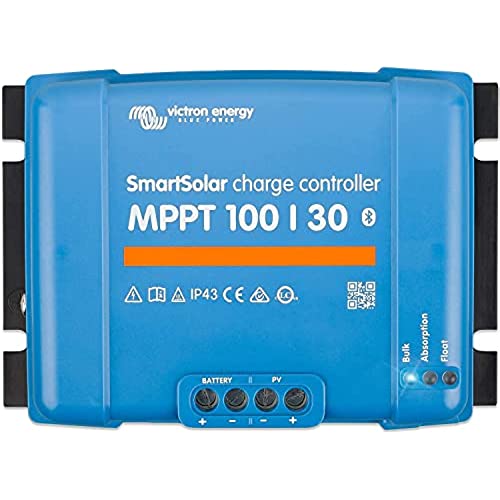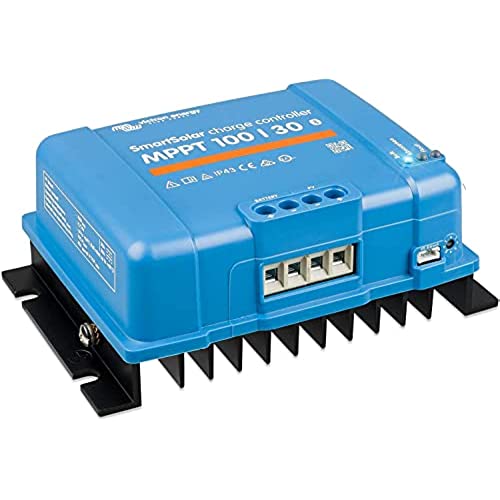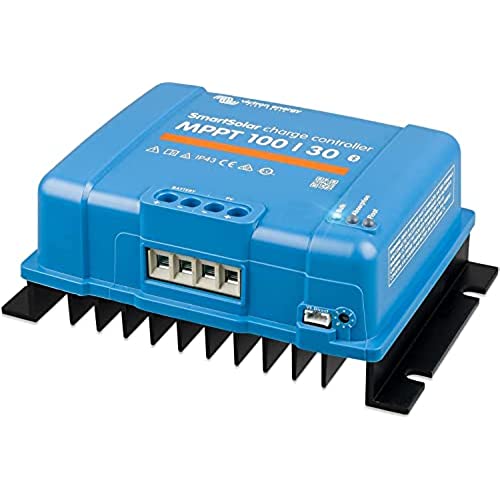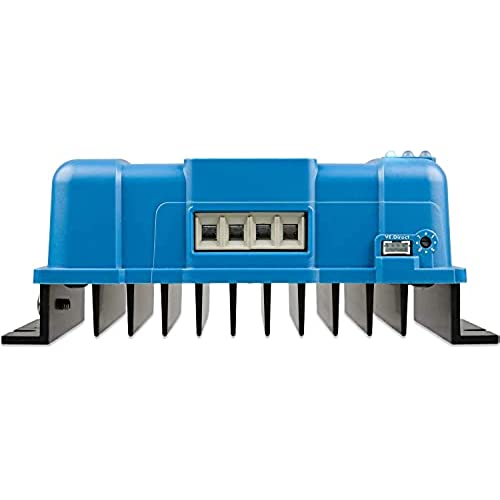









Victron Energy SmartSolar MPPT 100V 30 amp 12/24-Volt Solar Charge Controller (Bluetooth)
-

Phil Geusz
> 3 dayI bought this for my first solar install-- 600 watts-- on a cargo trailer converted to an RV in spring of 2018. This unit was so painless and easy to configure and use that I purchased a second Victron as part of an identical twin solar setup Ive now installed in my home to power my computer stuff and TV. (Yes, this review was written on solar power.) Its ludicrously easy! My only quibbles-- not enough for me to take off a star-- center around the smartphone app. (In my case its the Apple version.) Its a good, well-organized app overall, but... First, if you have more than one controller in more than one location as I do, you have to close the app entirely between checking them or else the software seems to become confused and wont register the second controller. Also, I wish the smartphone could remember at least the last data it dowloaded, so that I could store the controller data from the trailers array and look at it later. As things are now I have to stand outside in the hot sun and study the arrays past performance, etc on the spot, as its only available while the bluetooth is actually connected. Update-- November 2018. Im still liking these very much, and have upped my home setup to 1200 watts at 24 volts nominal. The Victron controller is handling it fine.
-

Benny B.
Greater than one weekI use this to charge my battery with solar. With the Bluetooth capability. Now I can monitor the status of my second battery.
-

Joe Elledge
> 3 dayI highly recommend this product. Just returned from a 63 day camping trip during which the Victron 20 Amp controller worked flawlessly. 60 of our 63 day trip were without shore power and relied on our 100 watt solar panel. While I have a generator, there was never a need to use it to charge our batteries. The Victron controller was part of an upgrade I did that replaced a cheap PWM controller, moved the controller from the solar panel to the battery box, and added 8 gauge wires from the controller to the batteries. The Victron controller charged my two group 27/66 amp hour batteries more quickly and more deeply than the PWM controller. My energy into the batteries from my solar panel now always exceeds my energy out (I track cumulative watt/hours). I could also run my fantastic fan during the day and my batteries would still receive an excellent charge. These MPPT controllers charger more rapidly than PWM by converting excess volts to additional amps. The Victron controller consistently stepped up the amps coming from the solar panel by as much as .7 amps. Excellent product!
-

B. Haddock
> 3 dayI have three Victron controllers and I love them. Glad I went with Victron. The three I have are the SmartSolar type with Bluetooth. The controllers communicate and I can monitor all of them through their phone app.
-

Ken
> 3 dayThis product has performed flawlessly on a 300 watt (3 x 100 watt panels) solar system into a 24 vdc battery. Initially started with using 200 watt (2 x 100 watt panels) solar system with a 12 vdc lithium battery before upgrading to the 24 vdc batteries (2 12 vdc batteries in parallel) to allow for the extra 100 watt solar panel. Panels are connected in series and the victron mppt handles it flawlessly.
-

Ram2500
> 3 dayReplaced a non working controller in a RV.
-

James Betts
> 3 dayLiked everything - ish it had a stronger bluetooth signal. Other victron units in same bay work great.
-

Sourdo
> 3 dayI recently installed two 100 watt Renogy solar panels on top of my RV trailer, along with a Renogy 30 amp PWM controller with a bluetooth dongle. The panels work fine, the Renogy SCC (Solar Charge Controller) not so fine. The bluetooth app is broken, crashes frequently, and is mostly a waste of money. While the Renogy SCC did its job, the performance on cloudy/shaded days was inadequate. With a PWM SCC, you must run your panels in parallel. You cannot fully charge a battery with 13 volts available (cloudy day in trees) from the PWM SCC, no matter what the amps is. With the panels in series, that 13 volts would now be 26 volts. So I ordered the Victron SmartSolar 75/15 MPPT controller with built in Bluetooth. With an MPPT controller, you have the option to run your panels in series or parallel. Running my panels in series doubles available voltage (up to around 40 volts, which the SCC converts excess voltage to the appropriate voltage (12 or 24 volts) and current (amps) to charge your batteries. This SCC handles this nicely. The unit was delivered in brand new condition. I was surprised how small it is. There are three LED indicator lights on the front. You cannot flush mount this device. I installed this inside a wall with a vent pipe, and ran my wires out the top of the RV via the vent exit. Where I mounted inside the wall, I used a tin lid against the wood. The instructions say to mount the unit on a non-combustible surface. I stacked two washers between the wall and tin, offering a better way to dissipate heat from the back of the device. If you look closely at the picture, you can see what I did. Then I made a facade cover with a small peep hole to quick view the LEDs. These LEDs are quite bright, some people tape over them. I would try a black felt tip marker to try and dim things first. There is no way to flush mount this unit. You cannot use wire bigger than 10 AWG. Some claim 10 AWG is too big, but that just isnt so. Just dont mangle the wire ends and theyll fit. But there is a better way, read below. What I do is to tin the wire ends. Strip off 1/2 inch of wire, give a slight twist to keep the strands tight. With a good soldering iron, solder the wire end, making sure the solder flows evenly. Not too much or youll end up with a fat end that wont fit in the lugs. You might practice this with a piece of wire, but once done correctly you have a superior connection. Then after inserting the end into the lug, tighten snuggly, then loosen, the re-tighten. Each time the lug will screw down a little tighter as the lug worms into the wire end. Ill do this at least 10-15 times, until the lug is snug and secure. Be careful to not over tighten and strip the lug. Use cable restraints. Once the battery is connected, hook up the PV array. I cover my solar panels with some plywood (or some cardboard) to turn down the open voltages while I connected those, which for two 100 watt panels in series is over 40 volts in bright sun and could shock you. I also installed a disconnect switch for the PV panels, next to that is the inverter remote switch. Your battery must be connected first, then connect the PV array. The one weak area of this device is the manual. It comes with a tiny booklet that is difficult to read. You can download the PDF version from Victrons website. Some of the info is sketchy and in not so plain English. For some info you need to install another app called Victron Toolkit. This offers explanations of the various blinking LED functions. The built in Bluetooth requires an app called Victron Connect(I have an Android Nokia smartphone) for reading power outputs, managing battery charging profiles, etc. The app was downloaded and installed without issue. With the app installed and paired to my phone, the app quickly upgraded the firmware for the SCC. Once this was done, the app works very well. I can walk about 40 feet away and can still stay connected, which is about normal for Bluetooth devices. Again, the app is well done and works well. The manual has some odd English to explain some of the functions. Ill try to explain in plain English as I see it. When you first hook up the SCC, the manual says 5+ volts from the PV panels over the Battery volts is needed to be operational (According to the manual). I would expect the unit to be operational when I bought it brand new out of the box. What this really means is this; When the controller sees 5 or more volts from the PV (solar panels) above the battery volts, it turns on the charger. When the PV volts drops to 1 volt or less then the battery volts, it turns off the charger. You can tell if the SCC is on and charging with a steady blue(or yellow or green, depending on SOC(State Of Charge)) LED, or off with a blinking blue LED every 2-3 seconds. When not charging, you can still use the Bluetooth. As the day progresses the LEDs will turn to yellow (absorption mode) to green (float mode) depending on clouds and trees, and of course electrical use. With my panels hooked up in series, mine starts up right about the crack of dawn and is charging in bulk mode with a steady blue LED. With the ability to turn off charging, I have notice right off my battery is still > 80% SOC (state of charge) when it restarts in the morning, even with the propane sensor on (my only parasitic load when parked). I like the Bluetooth app. It gives you complete control over battery settings and you can use just about any type of battery including lithium. The app also has a handy history function that is very useful. Some people complain about the range of communication with the Bluetooth. Mine functions like any Bluetooth, about 40 feet of range and that is that. Even with the SCC inside a tin covered RV and me outside, it works fine. I hope someone reads this before going with a PWM charger. For a few more bucks you can have a superior solar system. But for the somewhat lacking manual, I have no cons for this device. I have also ordered the Bluetooth battery temperature and voltage monitoring device for better charging. My batteries are outside the RV while the SCC is inside, this can skew charging parameters. https://www.amazon.com/gp/product/B07RTYGMBD/ref=ppx_yo_dt_b_asin_title_o01_s00?ie=UTF8&psc=1 I use two Duracell 78 ah AGM Ultra group 24 batteries along with a 1200/2400 watt inverter, so far this is working out well. This device has load outputs. For the average RV person setting up a simple solar system, this can be ignored. Run your 12 volts supply from the battery as it was originally wired. UPDATE July 1st, 2021: I have recently added two more Renogy 100 watt compact solar panes to the other two, making a total of four. To get these to work on the Victron 75/15 Smartsolar charger, I created two groups of two panels in series, then connected the two groups in parallel. Any other way would be over the rated amps or volts (depending on how the panels are connected. This setup delivers to the battery 15 amps @ 13.6 volts (float), which is as high as it can go. Volts remain the same as the original setup with two panels in series, about 43 volts. I just get double the amps. If I want to get the maximum amps I need to buy the next size up, the MPPT 100/20 controller. As it is now with four 100 watt panels, the charge controller works very well. With 4 panels connected, it turns on quite a bit before sunrise. The extra panels are very helpful in shade or cloudy days(or both). And when the sun shines, the output is strong.
-

Kamron Altenwerth
> 3 dayLiked this controller from the moment I took it out of the box. Has a good solid feel and looks like its quality built. Installed it near my battery bank and close to my BMV 712 battery monitor. Once hooked up firmware updates took over but once finished I was surprised at how well the controller and monitor shared information. If battery monitor has temp sensor battery charge rate is temp compensated using the shared data I am using a 160 wat portable unit so I had to maximize power harvest as much as possible. Cut the supplied, cheap, PWM controller out of the circuit then wired panels in series. Feeding over 43 volts into this controller and am charging with 90% of the panel capacity with just morning sun that hasnt reached optimum height/angle. Well worth the price and the BT connectivity is priceless. A perfect mate to a BMV 712 battery monitor. I bought the 15 amp model even though the max output of my panels in series is less than 4 amps. For the slight difference in price over the 10 amp model I now have room for a larger PV array if I ever choose to upgrade.
-

Little Foxxie
> 3 dayWorks better than I expected to it does exactly what it says and it works perfect for a battle born battery no problems with it very happy purchase Having built-in Bluetooth helps a lot if you dont have to buy the extra dongle for communication I really like the fact that its customizable you can set the parameters that you would like for your setup which is extremely helpful For whatever reason it seems to produce a little bit more voltage and current then I would expect it to thats probably what its designed to do but its a major Plus to me







